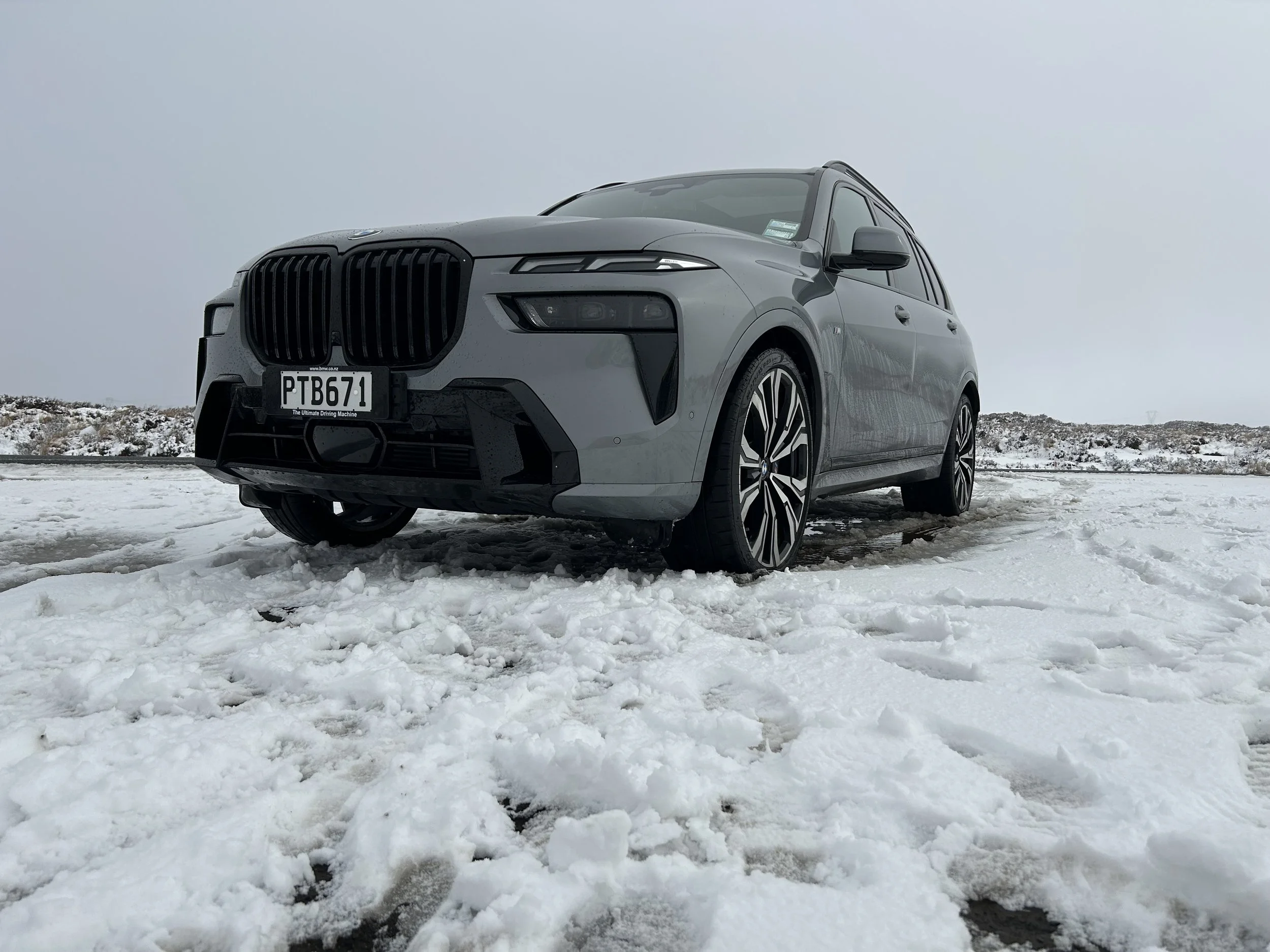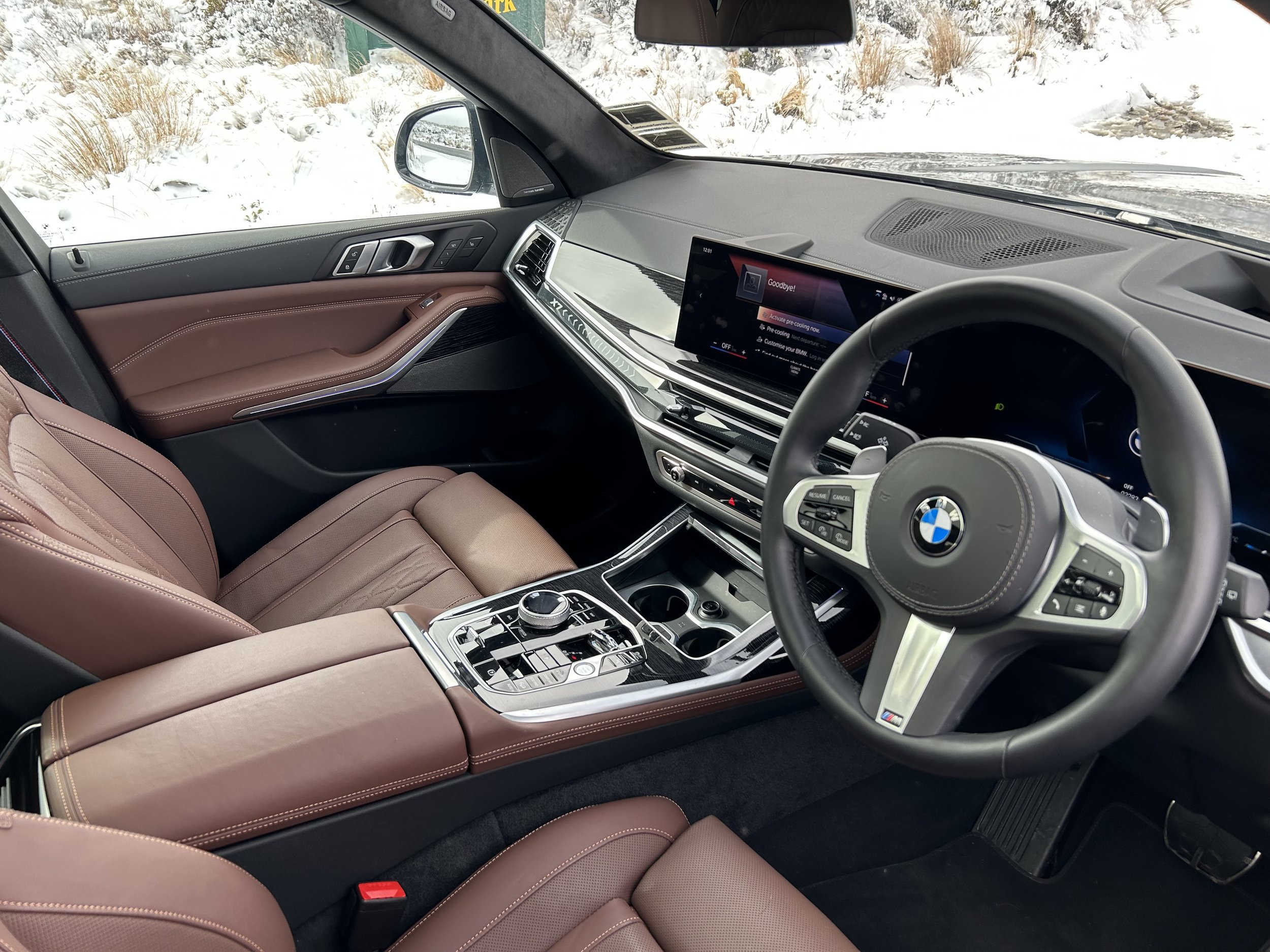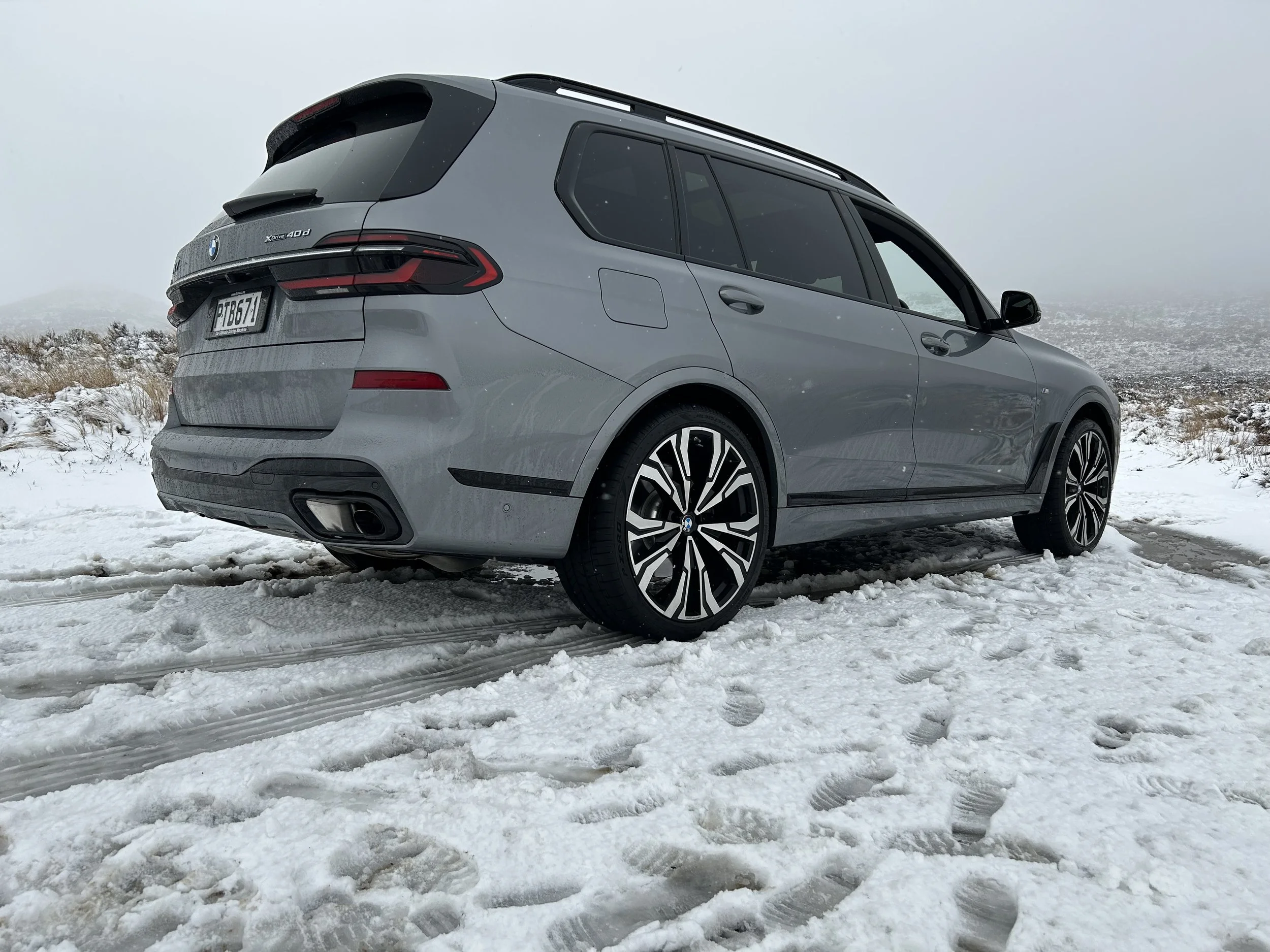BMW X7 xDrive40d road test review: Laidback luxury gone large
/Diesel is not the future. Yet, in this setting, it’s hard to imagine a better engine.
Price: $177,700 ($193,500 as tested).
Powertrain and economy: 2993cc in-line six cylinder turbodiesel with 48 volt assist, 259kW/720Nm; 8L/100km, 230g/km; eight speed automatic transmission; four-wheel drive.
Vital statistics: 5181mm long, 1835mm high, 2000mm wide, 3105mm wheelbase. Luggage space 326-2120 litres. 22-inch alloy wheels.
We like: Improved styling and cabin refit; quality; effortless engine; friendlier driving feel.
Not so much: Asks for a deep dive into options to deliver fit out; only makes more sense than an X5 when family issues require consideration.
BIG isn’t big any more and, as much as batteries are very much the ‘in’ thing, diesel still strikes as being highly beguiling.
So sums up time spent with the latest generation of BMW X7. While a massive, heavy SUV isn't really the kind of car any of us should be buying right now, I found it hard not to be impressed by this one.
An opinion I expected to form? Every test is approached with an open mind and yet … well, this car has baggage.
It’s the one X that should make anyone a bit cross because it really speaks to excess.
Just to remind. When BMW set up car making in North America, it had two models in mind, one small - the Z3 roadster - which struggled and the other carrying more substance, which succeeded massively.
The Spartanburg, South Carolina, operation that has become Munich’s largest factory anywhere has been X5 central from the start. The initially Five-Series sedan-based sports ‘activity’ vehicle (because, for BMW, the word ‘utility’ seemed too everyday for its image) not only massively lifted BMW’s fortunes and status Stateside, but has become a global giant.
Within the last decade, BMW found X5 fervour dwindling in the US. Even though each generation has consistently enlarged, on sales turf in which - and surely there’s no co-incidence here? - the buyer type seemed to be … ahem … ‘over-sizing’, the car was being called undersized for full-blown family requirement.
What to do? You see it here, in factory-fresh updated form. The X7 has the same platform and powertrains as X5, but body size-wise the blueprint upscaled, to point of it becoming something the X5 has never been: A full-out seven seater.
At what cost? Keeping X7 Stateside was never going to be a consideration. It was expected to follow the X5 on a global adventure.
Yet, when the larger type first introduced here, in 2019, it seemed an embarrassingly huge vehicle in which to be seen. My first ever time at the wheel was from the Southern Hemisphere Testing Ground to Queenstown. Heading off the Pisa Range, then across the Crown Range Road, on a moon-less night became a test of nerves. In that inky darkness it seemed hulkingly huge for that route.
Now we’ve met again, for a week. This time on home turf and with seven days’ involvement. At 5.2m long and 2m wide, this vehicle still imprints tangibly, of course.
How could it not? On a narrow country road or, more tellingly, in a cityscape, it’s still one of the bigger involvers. Parking in town is a challenge; it really fills an angle space and, of course, you’ve then got to allow enough room either side to get the doors opened. On a shopping expedition, there were good reasons for taking it to the quiet end of the supermarket car park. Even then, I was grateful for the surround view camera. Reversing from angle park, you’ll also be grateful for the sensitivity of the auto braking designed to keep you from striking something in the street.
So it’s still a big thing. All the same, tensions have eased considerably. But I don’t think it’s just meeting this model on more favourable terms has been the reason.
The car as I know it first is hardly the car I re-connected with. In as much they are one and the same in dimension and kilo count in look, and also in driving feel, there’s a lot of change, all likeable.
BMW doesn’t do facelifts. In Munich-speak, they’re Life Cycle Impulses. All I can say it that, in this case, the LCI required considerable surgery time, from a bigger team than would be required for a rhinoplasty.
A wholly reinterpreted front end, a comprehensive interior rejig, added gadgetry - not least 48 volt mild hybrid tech for the powertrains - and an enhanced specification were no small feat. But it’s a better car for it.
Starting from the front, there’s a friendlier face. By dropping the big, shiny grille of old and the conventional headlights for the same kind of split-level LED lights seen on the BMW i7 electric sedan and the 7 Series - driving lights at the top, main ones, with adaptive LED tech, further down - makes it a lot less confrontational in front-on appearance. It’s still big in the rear-vision mirror, of course, but nonetheless makes it seem sleeker and slimmer at the front. So even though metalwork down the sides and around the back has barely changed, the car has less ominous character.
The obvious change to the interior has been the addition of the sweeping digital screen - actually, it’s two screens, a 12.3 inch driver’s display and a 14.9 inch infotainment portal, but artfully conjoined - that starts behind the steering wheel and stretches half-way across the dashboard. Running the latest version 8.0 of BMW's operating software, it’s really cutting edge, has software that can update itself over the air and includes online connectivity functions, including using your smartphone as the car's key.
The navigation system has also been updated and now includes augmented reality, which overlays directional arrows on a live image of the road in front of you, taken from the forward-facing camera.
Some say the menus and 'buttons' look a touch cartoon-ish, but I think the high-def resolution is brilliant and overall operability is as good as they get, really. Perhaps migrating all of the heating and ventilation controls to the screen is a bit mis-judged. Call me old-fashioned, but even though it’s smart that the temperature controls remain on-screen, all the time, no matter what other functions you're accessing, there’s nothing better than a manual control for those. As is now normal for BMWs, you have options to using the system. If using the iDrive remote to navigate around seems awkward, you can gesture or, even better, voice control, working with a digital assistant which seems pretty good with New Zealand accents, at least to point where it consistently ‘gets’ the fundamentals - like ‘radio on’, ‘I’m cold/hot’ and so on. Kiwi place names are more of a challenge.
Pre facelift the X7 had an integrated screen and, yes, you can tell the new one is an add-on. A plastic clamp that holds the left-hand end of the screen is proof of that. But it’s nonetheless a better ingredient and that it has demanded a complete rejig of the entire centre console is no problem, even though the slim air vents being controlled with neat little joysticks speaks to engineers and designers having a bit too much time free reign. Another finishing touch that might risk groans from some is the interactive light bar; backlit section of the dash that includes the X7 badge which changes colour according to either your preference or the driving mode.
Revised controls see the gear selector now being a small tab, rather than a chunky lever as before. The rotary iDrive controller is as before, but the driving mode buttons are easier to fathom and there’s a logical control for the air suspension height which you’ll empty when, as in my case, your partner is on the short side and complains the car’s regular ride height is too tall. The car will lower easily and quietly to make access and egress easier - once, that is, your impatient other learns that, for obvious safety reasons, a door cannot be opened before or during the process.
Overall quality levels are absolutely top drawer, all the moreso in the test car which had an optional $10,000 luxury package, which includes the ‘Skylounge’ glass roof that incorporates the third row plus lighting behind the kidney grille, and also a M Sport Pro package that titivates the exterior and delivers a $2500 retracting tow bar, plus M-Sport brakes and exhaust. Go without those and the standard car is $177,700. With its finery, this was a $193,500 buy.
As provisioned, the test example was plenty plush. The basic elements of five-zone climate control, a 20-speaker Harmon/Kardon surround-sound audio system, many heated surfaces - including the armrests - cupholders (some of which warm or chill, at command) and comfort front seats with every adjustment though the massage function was extra. Brown leather is a big thing for German cars; it’s a bold ‘trad rugby ball’ hue, here, but I liked it.
Space. That’s reason why X7 was created and why it sells. On that note, the iX and, XM will ultimately seem airier, because the battery approach allows for a differently-dimensioned box; no gearbox having to sit between the front chairs, no driveshaft to require a big hump down the middle.
The X7 also having a ginormous centre oddments big between the front chairs also engenders impression the front row is a bit snug. But you only need to explore the rest to the cabin to figure that, the car as a whole is anything but.
The middle row of seats is royalty-ready, with heaps of legroom, kneeroom and headroom. Those behind that are more snug. You have to have the seats slid as far back as they'll go to really feel as if there's the sort of room the exterior size might lead you to expect. But even when left alone, that area is fine for kids or smaller staff; their challenge is more to do with restrictions on knee and lower leg room. The X7's tall, square rear styling allows lots of headroom.
All the seats have electric adjust and everyone has access to the climate control, a five-zone affair with buttons for altering the cabin temperature on both sides, as well as heated seat controls.
With all seats up and in use, the boot space shrinks to 326 litres, but fold the third-row seats down (done electrically, at such measured pace you initially wonder if there’s a fault) and you achieve a more cavernous 750 litres, deep enough that groceries that roll toward the seat backs cannot be reached from the boot side (top for beginners: Don’t lower the bottom part of the Range Rover-style split tailgate). And that’s just to the luggage cover. Fold down all the seats and there’s 2120 litres’ capacity.
The X7 doesn’t seem to have a wholly electric future - BMW accepts, it seems, that it’ll have to start again for a battery-pure ‘iX7’ equivalent. Prospect of this current model even achieving a plug-in hybrid, as X5 has in some places, seems vague.
Clean Car sensitivity fuels BMW’s electric car push, but it also does’t keep it from also selling the X7 M60, which runs a 390kW/750Nm 4.4-litre twin turbo petrol V8, that consumes 12.2L/100km at best, costs $232,800 then cops a $6800 emissions fee.
The twin-turbocharged straight-six diesel in the model in test doesn’t completely sidestep the legislation either, but while its CO2 count of 230 grams per kilometre is still high enough to draw a $3162 fee, it’s a markedly cleaner engine than the top petrol. And a far more fuel efficient one.
Ff you have to have a combustion engine, then going to the oiler is a far more sensible logic for something of this size and substance. Sure, you lose 141kW less power, but in respect to torque, the diesel is just 20Nm behind. And the towing rating for both is the same.
Also let’s agree, BMW has always had an absolutely cracker with this 3.0-litre unit; even among its immediate peers, its a particularly muscular and schmoozy choice.
The electric enhancement isn’t Green-washing. Sure, it never runs on pure electricity yet, though labelled a mild-hybrid system, having a crankshaft-mounted starter-generator on the eight-speed automatic gearbox, with a small battery to hold its charge, will further stretch the economy advantage diesel has over petrol.
Here it will chime in with a bonus 200Nm of extra torque as and when you need it, allowing longer stop-start operation around town and engine-off 'sailing' in open road cruising. The engineering for this implementation is impressive; the drivetrain shuts off at the traffic lights, of course, and restarts from that are swift and seamless. Nice.
Aside from that, there’s the sense that, while not outright sporty, the X7 in this xDrive40d format has more than adequate shove, for something this substantial. Step off is brisk but it’s the mid-range performance that will be appreciated even more. You’re getting full force from a lowly 1750rpm. That means it is exceptionally muscular and, also, remarkably refined. For the most part, engine noise is barely heard. In that respect, it is the most undiesel-like diesel I’ve met this year.
The maker-cited eight litres per 100km economy was not accomplished on test, but at end of this drive the average of 9.6L/100km nonetheless seemed more than enough. On a full 80-litre tank of diesel, it might be possible to exceed 1000km before you needed to refill. For sure, this engine is on notice, now, and there are good reasons why it should be. But it reminds that the benefits it brings, including 3500kg towing, cannot be easily mirrored with an electric drivetrain. Maybe hydrogen is the answer.
In respect to the dynamic side, you’re asking way too much to expect it to be at the same level of competency as an M3, of course. It’s just not. But while it is big, it doesn’t now feel as cumbersome as I recollect from that first encounter.
Yes, it still fills a narrow road. And yes, you will always sense it is overall better for occupant comfort when running in either Comfort or EcoPro driving modes, with the air suspension set to soft, rather than in the outright Sport element, which tightens it up but also reduces the car’s overall serenity.
But what does seem evident now is that it has improved body control; it feels lighter and more accurate on its feet than you would imagine it might. Only up to a point, of course. Go too silly and the laws of physics will inevitably involve and remind what it is you are playing with. Even though, though, the driver is given plenty of warning, with the first signal being dogged understeer, but not necessarily any loss of grip. overall, though, it’s a car that works best when driven in a way that engages but doesn’t enrage. Optimising the mechanical smoothness and refinement really matches the type’s comfortable and laid-back character.
In terms of safety, the X7 hasn't been individually tested by Euro NCAP (so there’s no ANCAP result, either), but the X5, with which it shares much of its structure and technology, has and that scored a full five-star rating, with strong showings for adult and child occupants and a creditable score for the protection of vulnerable road users.
As part of the update, the forward-facing autonomous emergency braking system has been upgraded and now reacts to oncoming traffic and improves the safety of others by warning the driver of pedestrians and cyclists approaching the vehicle parallel to the road from the front or rear.
New Zealanders have not yet fallen out of love with diesel … in certain classes. Clearly it’s the go-to with one-tonne utilities but the picture is a bit different for large luxury sports utility wagons; some - notably in the VW Group - are now starting to head the plug-in hybrid petrol way.
That’s a reaction to preference, but not in this market. Really, so much about what we ultimately see here comes down the what the dominant right-hand drive market prefers. That’s the United Kingdom.
Brits are falling out of love with diesel faster than logic says thy should. After all, not so long ago they were the loudest advocates for a fuel that cleverly managed the trick of pulling off lower fuel consumption, exhaust emissions and running costs for great economy, effortless grunt and longer range between refills.
But then came the emissions scandal. That triggered some anti-diesel rhetoric and gave cause for a change to diesel car tax regimes. plus, London’s ultra low emissions zone rules especially castigate diesel.
If Brits stop buying diesel SUVs, then BMW might well have cause to reconsider its strategy for all other right-hook markets. That hasn’t happened yet. And might not happen at all. Meantime, the biggest challenge to bringing in vehicles from the US could well be the lamentable exchange rate. Premium cars command premium prices, but X7 drivers will need to run big mileages to get value from their spend.



















